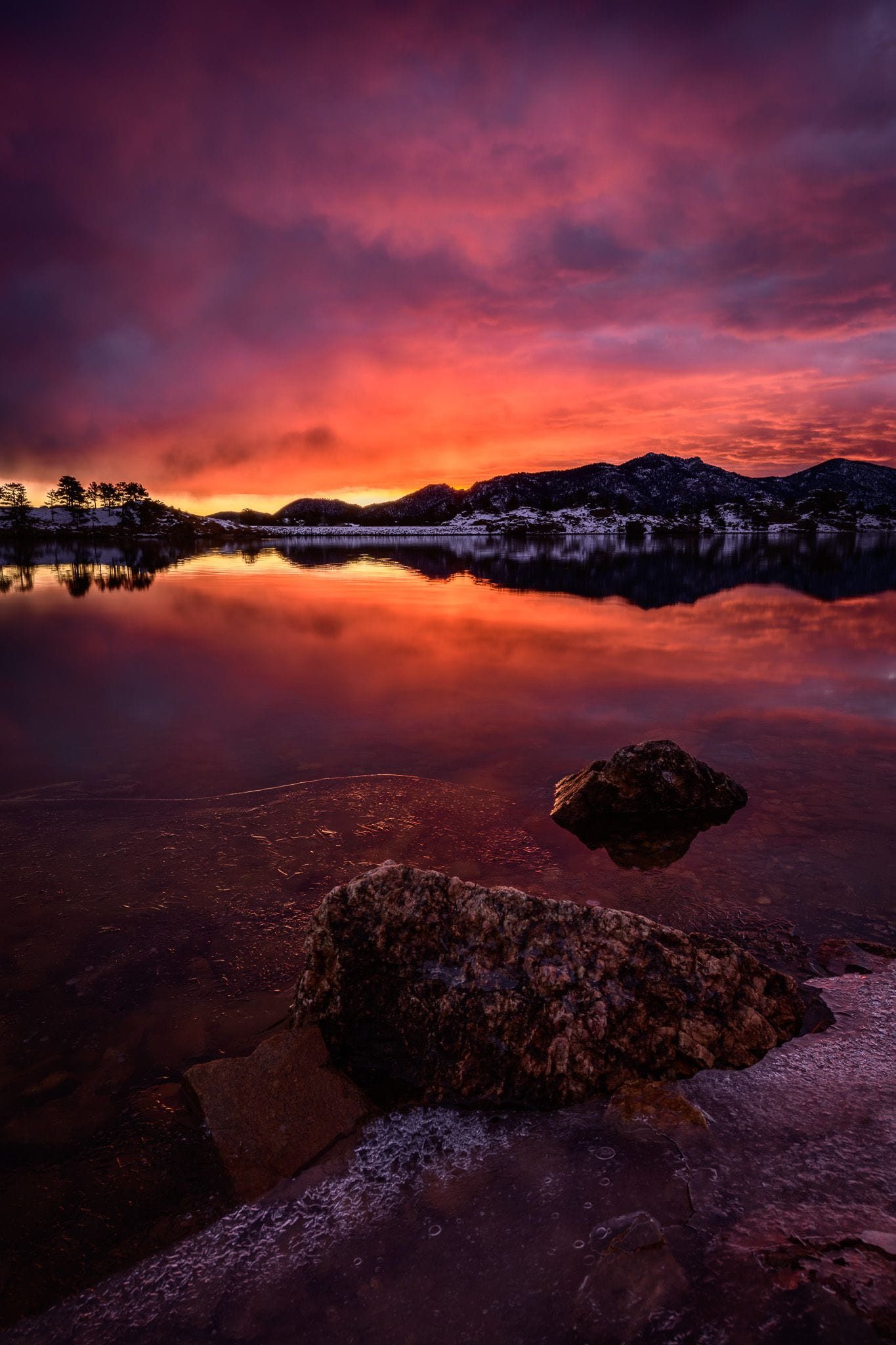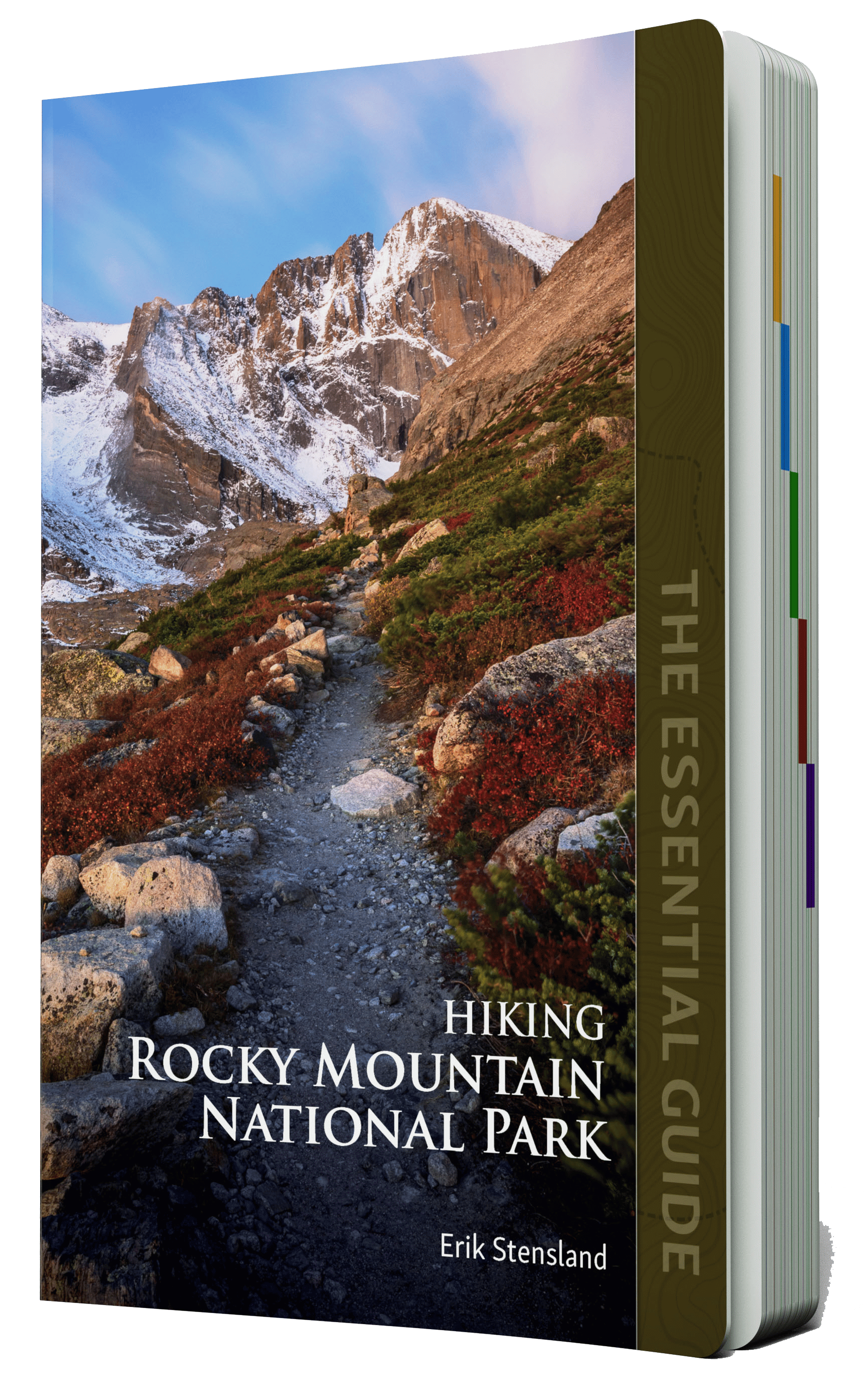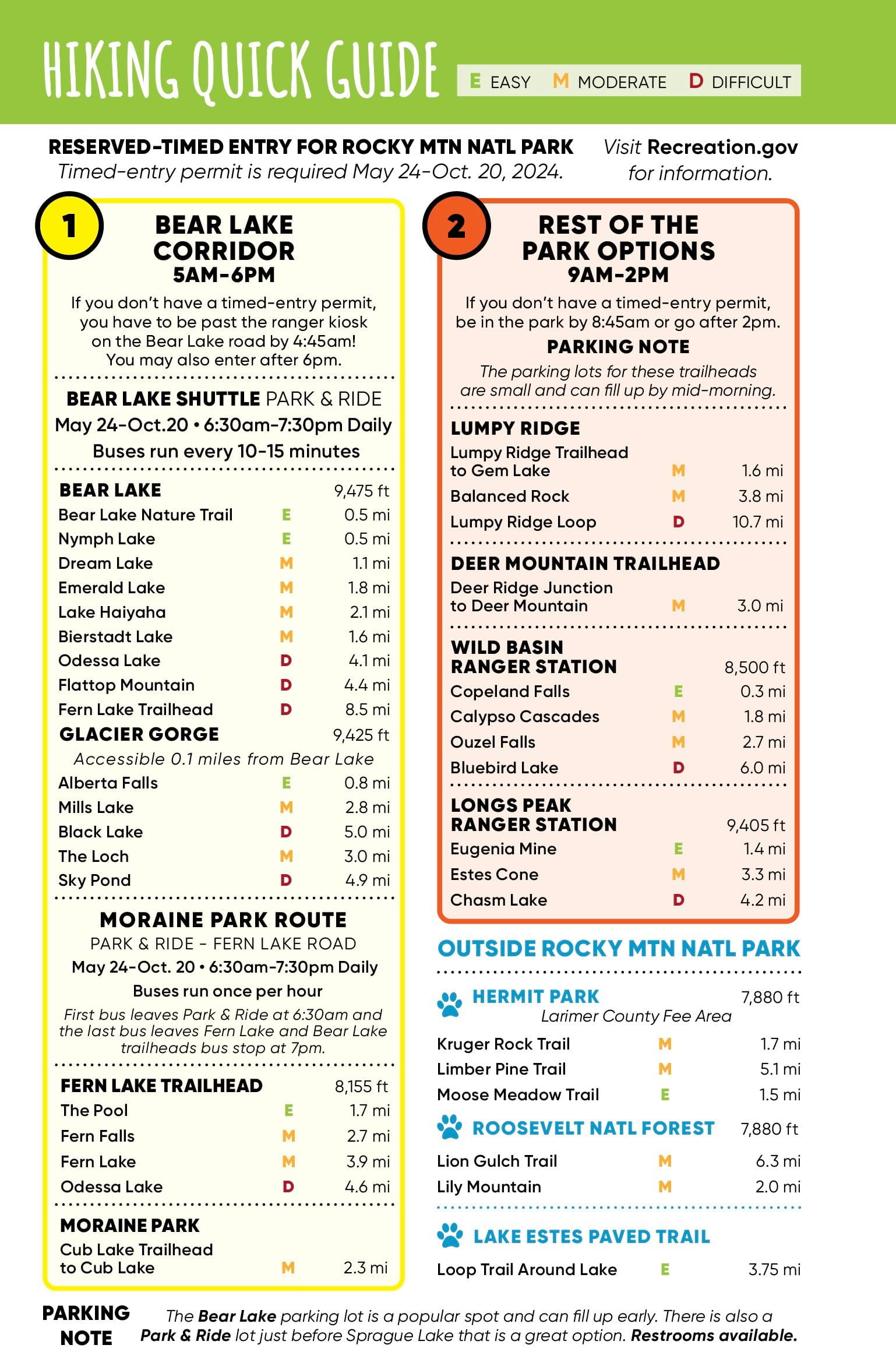Hiking

Hiking in Rocky is one of the most popular and asked-about things to do. The 415-square-mile Rocky Mountain National Park has more than 350 miles of hiking trails that take you through mountain meadows to alpine lakes, stunning waterfalls, and vivid tundra above treeline. Rocky boasts more than 60 mountain peaks of more than 12,000ft in elevation.
Being part of nature, seeing one of those high-alpine lakes, or hiking on a trail on the tundra is a great way to unplug.
Hiking is perfect for all levels and nature is good for everyone’s soul. We have some tips to help with your day hiking.
With more and more people out, our trails are being heavily impacted. Having good trail and outdoor etiquette will help protect the places we explore.
Don’t Rush In
Even fit individuals coming from lower elevations may experience problems with altitude. Before heading out for your adventure, make sure you are acclimated to the elevation and, more importantly, know your limits! You won’t prove anything by having to hitch a ride in an ambulance.
Be Prepared
No matter how short your hike is, always go prepared! Have a good backpack with water, food, a warming layer, rain jacket, sunscreen, a whistle, headlamp, a map (the old-fashioned paper kind!), and a first-aid kit. Maps are available at Rocky’s visitor centers.
Trail Ethics
Cutting switchbacks or walking off trail causes trail erosion and destroys precious subalpine and alpine flora that provide nutrition and water for high-
altitude critters. Always stay on the trail.
Never throw or kick rocks over the side of a mountain. They are a danger to the hikers or animals below.
On the trail, walk in single file and step to the side for faster hikers. Give horseback riders (who always have the right of way) and uphill hikers the right of way.
Reminder: Dogs are not allowed on any trail in Rocky Mountain National Park.
Choose Wisely
Choose your hike, not only according to your fitness level, but also your comfort level. You will have more fun if you’re within your limits. Plan your hike according to the slowest person in your group.
It’s much easier to climb up something steep than to come down it, so don’t put yourself in a bad position.
Remember that hiking to your destination is only half the journey; you still have to hike back to the trailhead.
Some trails are incredibly popular so the trail could be crowded. Consider a hike in a less crowded area of the park. You may have a more enjoyable experience that’s still stunningly beautiful.

Don’t Go It Alone
Do not hike or climb alone. Most accidents happen to those going solo or those who fail to tell someone where they are going. You can share your location before you go. This could help if you don’t return on time.
Always tell a reliable person your route and plans. Make sure to let them know when you are back safely.
Happy Feet
If your feet are happy, the rest of your body will be happy. Sturdy footwear with traction and support for your knees and back is essential. Hiking boots or beefy running shoes will work. Don’t wear flip flops or sandals. Traction spikes are great for when the trails are snowy or icy.
Wear a good pair of wicking socks, made of wool or a synthetic, not cotton. Carry an extra pair of socks.
Don’t Rely On Your Cell
Cell service is spotty, at best, so don’t rely on your phone to work. Popular topo and map apps will really drain your phone’s battery. If you were planning on using an app as your only map, don’t.
When your phone dies, then you will not know how to find your way back. And, if needed, you will not be able to call for help.
Watch the Weather
The weather in the mountains changes quickly and without warning. Storms can roll in quickly and with little to no warning.
Summer mornings are generally crystal clear with a cobalt blue sky. Afternoons often bring thunderstorms, but then the sky clears for a pastel sunset. Start out early and be well prepared.
Cairns
A cairn (Gaelic for rock mound) can be a trail maker and are placed by those who built or maintain a trail.
Do not build one as an homage to your trip. Added cairns can be confusing and dangerous to other trail users.
A Good Pack
A backpack that contains the proper supplies is really important for your day of hiking.
Your pack needs to hold all of the essentials. Invest the time to find a good pack that fits you and is comfortable.
No matter how far and long your hike will be, it’s crucial to have certain items with you. Never go without water and extra clothing (including rain gear).
The following list may seem big for a simple hike, but you never know. Don’t skimp on being prepared.

Essentials to Have With You
- Extra Clothes—Avoid cotton and always have a warming layer, such as a fleece pullover, and then a shell for wind or rain. Thin gloves are great to have as well. Proper clothing is incredibly important and potentially life saving.
- Hydration—You need to drink at least four quarts of water (or more) a day. Carry a hydration pack or water bottles. Taking small sips often is better than occasional large gulps. Drink lots of water and get plenty of rest the day before so you will enjoy your hike. If you start the day dehydrated, there’s no way to catch up!
- Whistle—To get someone’s attention in an emergency.
- Headlamp/Extra Batteries—You don’t want to rely on your phone’s flashlight if it gets dark. It will eat up the battery.
- Shelter/Trash Bag—A large trash bag will help keep you dry and add a bit of warmth in an emergency. Additionally, don’t forget the small bag dedicated to trash. Carry out all trash please.
- WAG Bag—A bag to properly dispose of your human waste.
- Sun Protection—Even if the day starts out cloudy, remember to bring sunscreen, a hat, and SPF lip balm. Apply often as sweat can remove sunscreen from your skin.
- Knife/Repair Kit—A small knife is always a good idea.
- First Aid—Always have a basic first-aid kit with you. Band aids, athletic tape, and a bandana are good basics.
- Physical Map—Always carry a printed map and know how to use it. No batteries or cell connection needed.
- Nutrition—Choose foods that are easy to digest and have high calories. Your body will need them. Sports bars, dried fruit and nuts, or the trusty peanut butter and jelly sandwich are popular choices.
Pro tip: Bring a water bottle with a drink mix for added hydration. Wrap some duct tape around the water bottle. Now you have tape in case you need to repair something.
The Poop Scoop
We really never thought we would have to include this in our book, but we do. If you have to poop while hiking, don’t just find a bush to do your business behind.
There is a proper and sustainable solution—a WAG bag (Waste Alleviation and Gelling Bag). Bags are small and lightweight so they are the perfect addition to your pack.
Really, they are not that bad to use. Once used, close the bag tightly and put it in the bottom of your pack. These bags are double walled, spill proof, puncture proof, and zipper closed.
They have crystals or gels to neutralize the dangerous pathogens in human waste. You can simply toss your WAG bag in a normal trash can once you’ve returned from your trip.
With more and more people visiting the area and hikers out on the trails, it’s critical this task be handled correctly.
Human waste takes about a year to biodegrade, harms wildlife of all sizes, and other hikers don’t want to find it stashed behind a bush or rock.
Where to buy them: Estes Park Mountain Shop, all Rocky Mountain Conservancy Nature Stores located in the Estes Park Visitor Center and all of Rocky’s Visitor Centers.

Finding your Way
Winner of the best travel book of the year, Hiking Rocky Mountain National Park: The Essential Guide, offers the most up-to-date and detailed information on the park. This beautiful book by local photographer Erik Stensland is filled with the latest information about 75 of the best hiking trails in the park and includes 80 custom-made topographical maps that identify waypoints you will encounter along the way.
Hikes are organized by difficulty level. The book has a companion website for any updated information. Pick up a copy in many stores in town or visit ImagesofRMNP.com.
Gear Up
Estes Park Mountain Shop sells hiking gear and boots, WAG bags, clothing, maps, and trail tags. 970-586-6548, EstesParkMountainShop.com.
Macdonald Book Shop carries a large number of books on hiking. 970-586-3450, MacdonaldBookShop.com.
Did You Know?
In a recent study, caffeine was found in close to 60% of the samples from 20 lakes and streams in Rocky. This told researchers that the humans are contributing to the nitrogen that feeds damaging algae in alpine lakes. Humans are peeing too close to water.
The rule? 100ft from any water. The other rule? Don’t leave your toilet paper or solid waste!
Be a part of the solution by carrying and using a WAG bag for solid waste, and carry a bag dedicated to used toilet paper when peeing.
